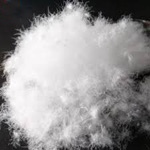|

Light and fluffy feathers found under the tough exterior feathers of birds are called down. Such feathers that mostly grow on the bird’s belly are naturally soft, fine and warm, and meant to protect the birds. But humans steal down from geese and ducks and keep themselves warm. As these feathers are soft and trap heat they are used to stuff pillows, quilts, duvets, sleeping bags and winter clothing such as quilted coats and puffer jackets.
No one waits for birds to shed or moult their feathers, or die naturally, so down from live geese or ducks is wrenched off. Feathers could be a so-called by-product of meat production or foie gras, but much more likely to be cruelly plucked off live birds.
Foie gras and down production are inter-related. Both involve intense torture for the birds. Foie gras is the liver of ducks, geese or guinea fowls used to make pâté de foie gras. It is extremely cruel: ducks are force fed several times a day with a funnel pushed down their throats till such time as their livers get ten times their normal size. They are then slaughtered and their diseased livers turned into a paste called pâté de foie gras. Birds that have been slaughtered are scalded in hot water for a couple of minutes making it easier to remove the feathers, often with a plucking machine.
Since it is not possible to gather feathers at the time of moulting, they are forcefully pulled out of live birds leaving bleeding, painful follicles.
It is totally unnecessary to torture geese and ducks for their down when alternatives are easily available to use as padding and insulation for bedding and winter clothing. Most 5-star hotel pillows contain goose and duck down although simal/kapok (silk cotton from the tree), fibres such as cotton, hemp, bamboo, and filling materials like Comforel (polyester fibre) are good replacements for down, and are readily available.
China, Poland and Hungary are the main suppliers of down, and about 80% of such feathers used worldwide are live plucked by firmly holding the geese or ducks by their necks or wings and ruthlessly ripping out their soft, fine, white feathers. The birds’ skin gets ripped in several places but it is considered routine and is just sewn up with a needle and thread. The birds are left thus to bear the pain, only to be subjected to the same ordeal again and again when their feathers re-grow.
Following the Government of India ban on import of foie gras, in August 2014 BWC wrote to the Director General of Foreign Trade pointing out that the production of feathers and down goes hand in hand with the production of foie gras and to therefore stop the import of all feathers and down, and also quills and scapes.
However by winter 2018 quilted down jackets became quite popular in India. Called puffer jackets, or bivy down jackets, they were marketed by high fashion brands as the ultimate stylish and warm winter-wear for men. Famous brand jackets have at least 550 cubic inches covered with one ounce of down used as insulation. A fill power of 800 is considered best to fill bivy or weatherproof nylon fabric with these soft and warm under-feathers from geese.
Quite often different down and feathers are mixed because a combination of geese down with duck down or even chicken feathers makes products cheaper although they do not turn out as warm. Ascertaining chicken feathers which are the cheapest is easy as they can be felt by pressing the material between fingers and feeling the hard feather shaft which eventually punctures the fabric.
Incidentally the Indian Army imports goose or duck down products from China such as jackets and sleeping bags for Jawans posted in high altitude areas. After the life of these products is over, they are auctioned and the down is recycled.
India’s Import Policy
Down feather pillow imports into India are mainly from China, UAE and USA.
Under India’s Import Policy 2012, feathers and down and articles made from them have been clubbed with artificial flowers and articles of human hair! “Feather dusters” and “other” items are “free” (allowed) to be imported subject to Wild Life (Protection) Act, 1972 and CITES (Convention on International Trade in Endangered Species). The same applies to “skins and other parts of birds with their feathers or down, feathers, parts of feathers, down and articles thereof”.
In 2019 BWC wrote to the Union Minister of Commerce & Industry requesting a ban on the import of down feathers. A copy of Compassionate Friend (spring 2019) which carried a article on the subject as well as pictures on the back cover was enclosed. |